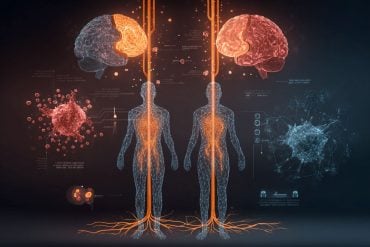Summary: Cold exposure in the morning could be more beneficial in boosting metabolism and burning fat in men than in the evening.
The study focused on brown adipose tissue (BAT), a distinct type of fat that burns calories to produce heat, particularly in cold temperatures. However, the same effect did not hold true for women.
The research suggests that interventions targeting fat metabolism should consider specific timing, with morning sessions potentially being more beneficial for men.
Key Facts:
- The study found that in men, cold-induced energy expenditure was higher in the morning, indicating greater activation of brown fat.
- The study did not find a difference in cold-induced energy expenditure between the morning and evening in women, though women were more tolerant of the cold in the morning.
- The researchers are now studying whether repeated bouts of cold exposure in the morning could improve cardiometabolic health in individuals with obesity.
Source: European Society for the Study of Obesity
Short-term exposure to cold temperatures activates brown fat that burns calories and has become an attractive target to promote cardiometabolic health.
Now new research being presented at this year’s European Congress on Obesity (ECO) in Dublin, Ireland (17-20 May) suggests that this biological response differs depending on the time of day and in men and women.
The preliminary study by Dr Mariëtte Boon from Leiden University Medical Center in the Netherlands and colleagues, suggests that cold exposure in the morning may be more effective at boosting the metabolism and burning fat than in the evening in men, but maybe not in women.
Brown fat or brown adipose tissue (BAT) is a distinct type of fat that is activated in response to cold temperatures. Its primary role is to produce heat to help maintain body temperature and it achieves that by burning calories, especially from fat.
“Our study indicates that the optimum time to undergo cold exposure is at a specific point in the body’s 24-hour cycle,” says Dr Boon.

“It may also be that there is a sex difference in how the body responds to cold exposure with respect to boosting metabolism at a certain time point, and it appears that delivering cold exposure therapies in the morning may be more beneficial than the evening for men.”
In rodents, brown fat metabolic activity fluctuates throughout the day, and is highest just before waking up.
This makes biological sense because heat production from food digestion and activity declines during night-time and waking up requires the body to increase its core body temperature.
But whether there is a circadian rhythm in brown fat activity in humans, and whether it differs in men and women when they are exposed to cold, is unknown.
To find out more, researchers conducted a randomized crossover study in 24 lean adults—12 men (aged 18-31 years; BMI 18-26 kg/m²) and 12 women (aged 18-29 years; BMI 18-26 kg/m²).
Participants underwent a 2.5 hour personalized cooling protocol using water-filled mattresses in the morning (7:45 am) and evening (7:45 pm), in random order and with one day in between these study days.
The water temperature was lowered gradually until shivering occurred or until a temperature of 9°C was reached. Participants were then exposed to stable cold for another 90 minutes.
Researchers measured energy expenditure (using indirect calorimetry) four times during the experiment—at the start under thermoneutral conditions (at 32°C when the body does not need to produce extra heat to maintain its core temperature), during the cooling down phase, the stable cold phase, and at the end of cooling (after 90 minutes). Supraclavicular skin temperature was also measured regularly with infrared thermography.
The analysis found that in men, cold-induced energy expenditure and skin temperature (both a proxy for brown fat activity) were higher in the morning than in the evening.
However, cold-induced energy expenditure and skin temperature did not differ between the morning and the evening in females, while the females were more tolerant to cold in the morning than in the evening (meaning they started shivering at a lower temperature in the morning).
Moreover, in women, circulating free fatty acid concentrations, triglycerides, and cholesterol levels were higher after cold exposure in the morning than in the evening.
The authors note several limitations including the inability to draw strong causal conclusions about the direct effect of cold exposure on cardiometabolic health. They also note that despite measures taken to control diet and sleep, other unmeasured lifestyle or genetic factors could have influenced the results.
“Nevertheless, this is an important first step investigating the effects of circadian rhythm on the effects of cold exposure on (fat) metabolism. We are currently studying whether repeated bouts of cold exposure in the morning improves cardiometabolic health in individuals with obesity.
“At the very least, our findings indicate that administering interventions at specific times should be considered when targeting lipid metabolism,” says Dr Boon.
Funding: This work was supported by the Dutch Heart Foundation (2017T016 to S.K.), by the Dutch Society for Diabetes Research (NVDO; Prof. dr. J. Terpstra Award to S.K.), the Dutch Diabetes Foundation (2015.81.1808 to M.R.B.) and the Netherlands Cardiovascular Research.
About this neuroscience and weight loss research news
Author: S Bryant
Source: European Society for the Study of Obesity
Contact: S Bryant – European Society for the Study of Obesity
Image: The image is credited to Neuroscience News
Original Research: The findings will be presented at the European Congress on Obesity (ECO2023)






